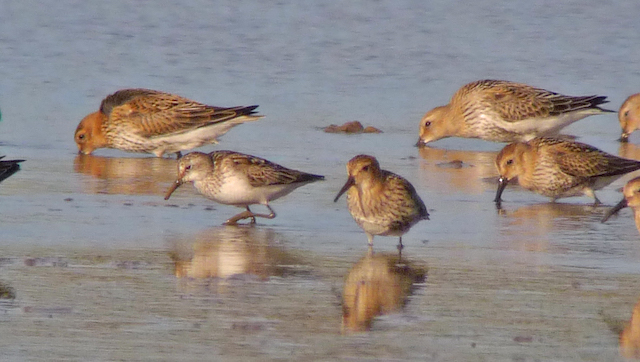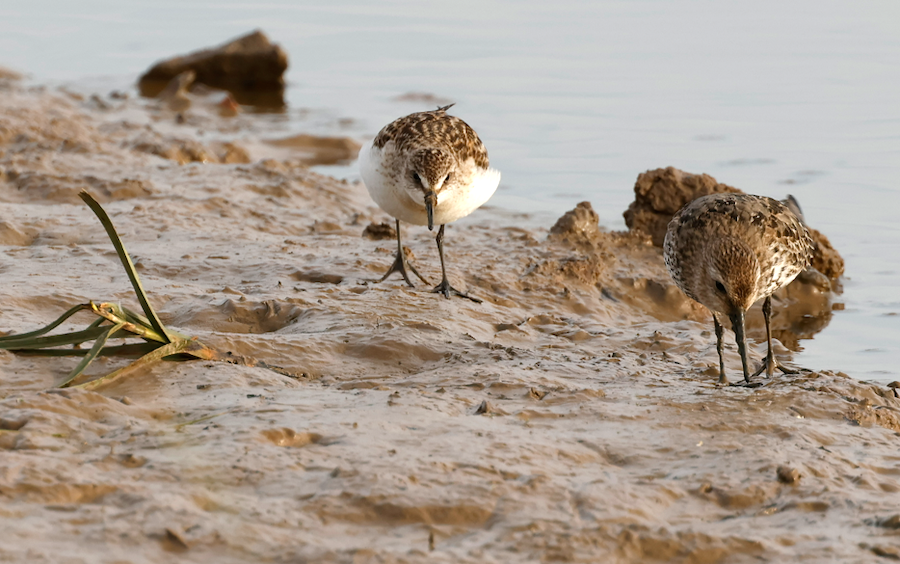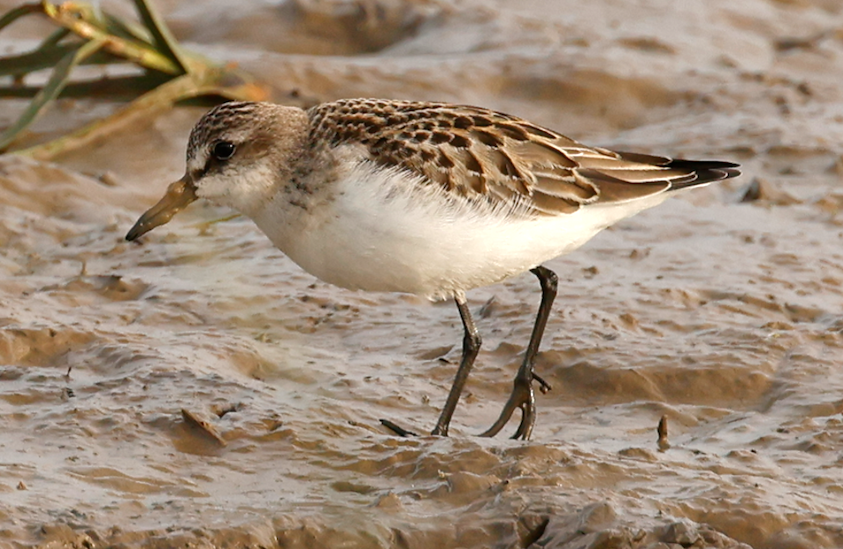Semipalmated Sandpiper Calidris pusilla



Not until 44 years later, on the evening of August 18th 2010 at Alkborough Flats, did the second county record occur, an adult. Photographs were obtained and they revealed semi-palmations on its feet, clinching the identification. Over the next six days the bird remained on site but was generally difficult to observe as it fed between 100m and 700m from the nearest footpaths. It was last seen on August 24th and had previously been seen just across the border in Yorkshire at Blacktoft Sands RSPB reserve.
The identification of this ‘peep’ remains a challenge and in the early years of claims of this species came under great scrutiny. Wallace (1979) published a review of 12 published British records (as well as claims of Red-necked Stint, C. ruficollis) between 1953-1974, and found only five to be acceptable, including the Lincolnshire bird of 1966 (it was trapped, after all). Later, Jonsson and Grant (1984) published a seminal paper on the identification of stints and peeps. Including the five accepted records published in the Wallace review, there has now been 156, 1950-2018, a veritable flood. Despite this, and with double figures in some years (17 in 2011, 11 in 2013) the species remains on the BBRC list for consideration and remains a challenge to find. Semipalmated Sandpiper is currently the ninth commonest Nearctic wader to have occurred in Britain.
| Site | First date | Last date | Count | Notes |
| Wisbech SF | 12/11/1966 | 26/12/1966 | 1 | 1CY, trapped 13th November |
| Alkborough Flats | 18/08/2010 | 24/08/2010 | 1 | Adult |
| Frampton Marsh | 02/10/2023 | 16/10/2023 | 1 | 1CY |
Looking back – November ‘firsts’ – Semipalmated Sandpiper.
by Matthew Harrison
Note: this is an extract from an article by Matthew which first appeared on the Lincolnshire Bird Club website in January 2005.
On 12th November 1966, a Semipalmated Sandpiper (considered to be a first-winter bird) was trapped at Wisbech Sewage Farm on the County boundary with Norfolk. This rather unseasonal individual then went on to make an extended stay until 26th December and during this time was witnessed by several observers. Although mainly observed feeding on the muddy sludge beds, it was also witnessed feeding actively in a large, ploughed field nearby, along the deep furrows. This was only the fourth British record at the time. Some 44 years later, on the evening of 18th August 2010 a check of the waders and wildfowl at the managed realignment site at Alkborough Flats a stint sized wader was located amongst a group of Ringed Plovers and Dunlin. On plumage colouration it was suspected the bird was an adult Semipalmated Sandpiper. After a while the birds flew closer and some photos obtained revealed the bird showed semi-palmations on its feet, clinching the identification. A few local observers made it to the site that evening before the flock moved much further away and the light faded. However, over the next six days the bird remained on site but was generally difficult to observe as it fed in various parts of the Alkborough Flats site, often being between 100m and 700m from the nearest footpaths. It was however witnessed by numerous observers and some good photographs and video footage were obtained of the bird. It was last seen on 26th December. It had previously been seen just across the border in Yorkshire at Blacktoft Sands RSPB reserve.
Semipalmated Sandpiper is one of the rarer Nearctic waders to reach UK shores and is a prize find. After the first record in Norfolk, at Cley in July 1953 there were only a further 5 records up to 1978, but since then there have been only four blank years for the species (1979, 1981, 1987 and 1991) with the record 7 in 1996 smashed three years later when an exceptional 17 birds were recorded including an exceptional September influx to western Scotland which brought no less than 8 to the Outer Hebrides. Twelve years later another record was set in autumn 2011 when 16 birds were recorded during the autumn, and by the end of that year the British total had moved on to 115.
Finder’s report: Semipalmated Sandpiper at Alkborough Flats, August 18th, 2010, second county record.
by N. Drinkall
Note: this article first appeared in the Lincolnshire Bird Report 2010. The BBRC report for 2010 noted that there were six records in that year and that this was a fairly typical spread, given that 85% of all British records are in the four months from July to October with the distribution also more or less as expected. Scilly is currently the top county for this species, with 12 records, closely followed by the Outer Hebrides with 11 (in large part due to the multiple arrival in 1999) and then Cornwall (8) and Devon (7). There are very few inland records.
Circumstances
On the evening of August 18th, 2010, like most other nights I set off from my home in Alkborough village to visit the managed realignment site half a mile away on Alkborough Flats to check the waders and wildfowl on what has become one of the best rarity-producing spots in Lincolnshire since its development in late 2006.
On the first muddy area west of the car park a flock of small waders attracted my attention and I set about scanning through the Dunlin and Ringed Plovers in the hope of a rarer wader. I quickly came across a stint-sized wader with the Dunlin and from its general lack of rufous tones in the plumage producing a black, white, and grey colouration I started to suspect that it might be an adult Semipalmated Sandpiper. There had been no Little Stints at Alkborough in the autumn to date and this was a ‘big’ bird to claim. After extensive looks at the plumage noting the old adult scapulars and flight feathers and the extensive grey wash across the upper breast, I was trying hard to get a good look at the feet to confirm whether there were palmations. At this point I rang Graham Catley (GPC) to try and get a second opinion, but he was doing a survey at Tetney and was at least an hour away and I was still not 100% certain of the identification I didn’t want to cause a mass panic over what may be a commoner bird.
After the phone call the flock of waders flew closer and I was now able to take some digi-scoped images of the bird and to view its feet which I was convinced now showed confirmatory semi-palmations after which the species is named. I rang GPC again with the news and then phoned other local observers including Wayne and Clare Gillatt, Roy Harvey (RH), and Craig Nimick, all of whom arrived within the next 30-50 minutes. Unfortunately, by the time other observers arrived the flock of waders had flown further away and in the rapidly fading light no further details were obtained.
Over the next six days the Semipalmated Sandpiper proved to be generally difficult to observe well, as it fed in various parts of the Alkborough Flats site but was usually 100-700m. from the nearest footpaths. Plumage and structural details seen on th1 8th were confirmed on ensuing days and RH obtained some video footage that showed the palmations just as a final confirmation of the correct identification.
Description
General appearance – the Semipalmated Sandpiper was smaller than Dunlin and Ringed Plover seen alongside it and judged to be like a Little Stint although none were present, but with a stockier and thickset profile. Looked hunched and short-legged at times and at others held posture higher and was more active when with other waders, when alone it slowly and meticulously picked objects from the surface. It was never heard to call. When seen alone it was very lethargic and fed with steady, probing and long static periods, but when with other waders was often more energetic and ran around, even at times probing more frequently.
Upperparts – scapulars black with pale inner centre and buff fringes. Upper scapulars black with very little fringing forming a black V across the upper back. Nape heavily streaked greyish brown; median, and greater coverts all dull brown grey coloured with pale, creamy-buff fringes. Tertials black with creamy fringes but no sign of any rufous colour in the tertial fringes. Tertials almost totally cloaked the primaries at rest with just 1-2 primary tips visible.
Head – crown dark grey-brown, streaked blackish on forehead and appeared quite capped in dull flat light. Supercilia started before the eyes and flared out behind the eyes over the ear coverts. Dark, blackish ear covert patch and loral area contrasting sharply with white chin and throat and extended collar that ran around and under the ear coverts.
Underparts – upper breast and lower throat marked with broad and a very obvious gorget of dark grey-brown streaks as deep in the middle as at the sides; a few streaks extended down on to the sides of the upper breast near to the flanks.
Bare parts – bill deep-based and with a slightly expanded tip, particularly visible when head-on. Palmations visible when foot spread when feeding towards the observer – in photos it can be seen to be wider between outer and middle toes than inner and middle. Legs and toes black.
References
Drinkall, N (Undated). Semipalmated Sandpiper Calidris pusilla at Alkborough Flats. Lincolnshire Bird Report 2010, p173.
Wallace, D. I. M. (1979). Review of British records of Semipalmated Sandpipers and claimed Red-necked Stints. British Birds 1972 (6): 264-274.
(Account as per new Birds of Lincolnshire (2021), included September 2022)

